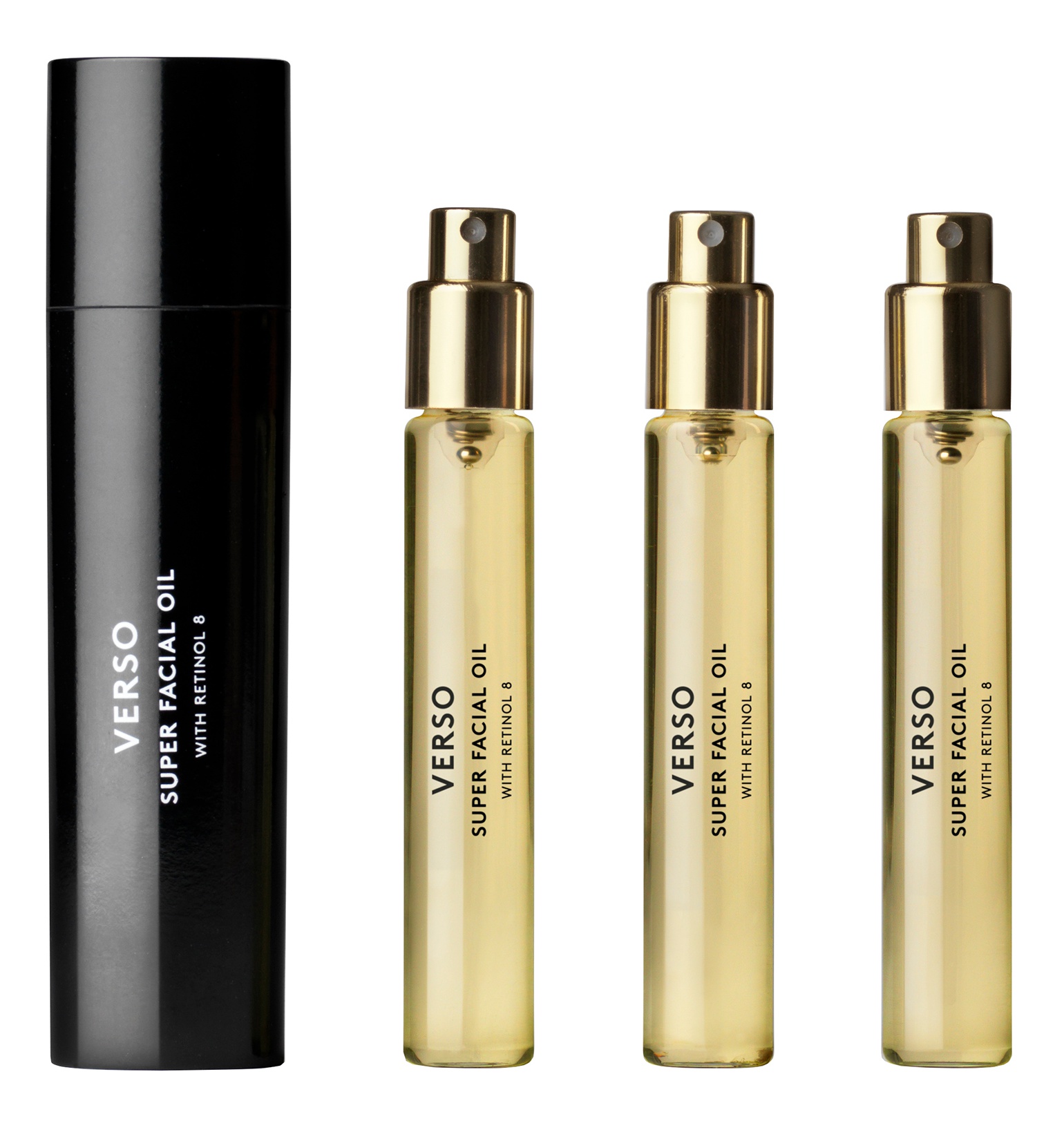
Super Facial Oil With Retinol 8
Highlights
Skim through
| Ingredient name | what-it-does | irr., com. | ID-Rating |
|---|---|---|---|
| Caprylic/Capric Triglyceride | emollient | ||
| Isopropyl Isostearate | emollient | 0, 4-5 | |
| Shea Butter Ethyl Esters | emollient | ||
| Caprylyl Methicone | emollient | ||
| Helianthus Annuus Seed Oil Unsaponifiables | soothing, skin-identical ingredient, emollient | goodie | |
| Tocopheryl Acetate | antioxidant | 0, 0 | |
| Canola Oil | emollient | ||
| Retinyl Retinoate | cell-communicating ingredient | goodie | |
| Tocopherol | antioxidant | 0-3, 0-3 | goodie |
Verso Super Facial Oil With Retinol 8Ingredients explained
A super common emollient that makes your skin feel nice and smooth. It comes from coconut oil and glycerin, it’s light-textured, clear, odorless and non-greasy. It’s a nice ingredient that just feels good on the skin, is super well tolerated by every skin type and easy to formulate with. No wonder it’s popular.
An oily liquid (ester) that makes your skin nice and smooth, aka emollient. It is described as highly emollient or substantive, but with a light and easy spreading and nonoily skin feel.
An "eco-designed" emollient ester coming from shea butter. While pure shea butter is a rich emollient that might feel greasy on the skin, this one is designed for its light, silky-soft feeling.
The manufacturer claims that it has a great sustainability profile, long lasting stability and a unique, light and silky feel that's ideal as a base for modern, eco-friendly body lotions and facial care products.
A clear, colorless, low viscosity, volatile (does not absorb into the skin but rather evaporates from it) silicone fluid that has excellent spreadability and leaves a light, silky and smooth feel on the skin.
According to manufacturer info, its big advantage is that it's compatible both with other silicones and with natural plant oils, so it's a great ingredient to formulate products with good-sounding, consumer-pleasing vegetable oils but still maintain a cosmetically elegant, non-greasy and non-tacky feel.
The unsaponifiable part of sunflower oil. It's the small part of the oil that resists saponification, the chemical reaction that happens during soap making.
If you want to understand saponification more, here is a short explanation (if not, we understand, just skip this paragraph): Oils are mostly made up of triglyceride molecules (a glycerin + three fatty acids attached to it) and during the soap making process a strong base splits the triglyceride molecule up to become a separate glycerin and three soap molecules (sodium salts of fatty acids). The fantastic Labmuffin blog has a handy explanation with great drawings about the soap-making reaction.
It’s the most commonly used version of pure vitamin E in cosmetics. You can read all about the pure form here. This one is the so-called esterified version.
According to famous dermatologist, Leslie Baumann while tocopheryl acetate is more stable and has a longer shelf life, it’s also more poorly absorbed by the skin and may not have the same awesome photoprotective effects as pure Vit E.
Retinyl Retinoate (RR) is a less well known but super interesting member of the retinoids (vitamin A derivatives), aka the "royal family of skincare". Unless you live under a skincare-news-shielding rock, you must have heard about tretinoin, the FDA-approved anti-aging superstar, and retinol, the most common OTC version of tretinoin. You can read more about whos-who in the retinoid family here.
Enter Retinyl Retinoate, a molecule that is created by attaching retinol to retinoic acid. The attachment makes the molecule more stable (pure retinol is unstable and hard to formulate) as well as more active. If you read our shiny description about retinol you will know that it is not active and has to be converted by our metabolic machinery to become retinoic acid, the biologically active molecule. The conversion is not very effective and takes two steps. Retinyl Retinoate also has to be converted, but in the first step, our cells break up the molecule to become retinoic acid (the active) and retinol, meaning that it becomes active both after the first conversion step as well as later on once retinol is further converted.
- Primary fat-soluble antioxidant in our skin
- Significant photoprotection against UVB rays
- Vit C + Vit E work in synergy and provide great photoprotection
- Has emollient properties
- Easy to formulate, stable and relatively inexpensive
You may also want to take a look at...
| what‑it‑does | emollient |
| what‑it‑does | emollient |
| irritancy, com. | 0, 4-5 |
| what‑it‑does | emollient |
| what‑it‑does | emollient |
| what‑it‑does | soothing | skin-identical ingredient | emollient |
| what‑it‑does | antioxidant |
| irritancy, com. | 0, 0 |
| what‑it‑does | emollient |
| what‑it‑does | cell-communicating ingredient |
| what‑it‑does | antioxidant |
| irritancy, com. | 0-3, 0-3 |






 We don't have description for this ingredient yet.
We don't have description for this ingredient yet.